NEETS Module 15 - Principles of Synchros, Servos, and Gyros
Pages i,
1-1,
1-11,
1-21,
1-31,
1-41,
1-51,
1-61,
1-71,
2-1,
2-11,
2-21,
2-31,
3-1,
3-11,
3-21,
4-1, Index
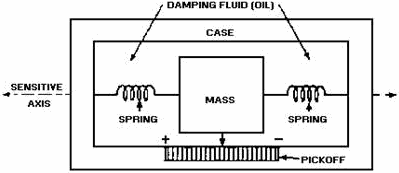
Figure 3-20. - The basic accelerometer.
An accelerometer is sensitive to gravity when its sensing axis is positioned so gravity can move or attempt to
move the mass. This is useful in that we can use gravity as a reference for testing purposes, but it can be a
serious problem because of the errors it may cause in acceleration measurements. If the unit is placed with
the sensing axis vertical, the mass will be displaced such that the output is one "G," or one unit of gravity.
This is done during testing. Then when the sensitive axis is turned so it is horizontal to the Earth, the springs
center the mass, and the output of the unit is zero. E-Transformer ACCELEROMETER
The E-transformer accelerometer (fig. 3-21) consists of a mass suspended from a calibrated leaf spring in a manner
similar to a pendulum. The mass is effectively the armature of an E-transformer of the type used as an error
detector in a servo system. The mass of the accelerometer is enclosed within a case that is filled with a damping
liquid, which helps keep the pendulum from oscillating. The accelerometer is mounted so that acceleration in only
the desired geometrical plane is detected.
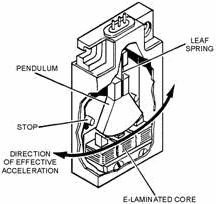
Figure 3-21. - E-transformer accelerometer.
3-21
Refer to figure 3-21. Notice that when there is no acceleration, the pendulum remains centered and the
accelerometer output is zero. However, when there is acceleration the mass or pendulum swings in the direction
opposite to that of the acceleration, causing an output from the E-transformer. Since the amplitude of the
pendulum's swing is proportional to the amplitude of the acceleration to which it is subjected, the output of the
device indicates both the direction and amplitude of the acceleration. This output is within the limits of
the equipment and is limited by physical stops. PULSE-COUNTING ACCELEROMETER The
outputs of the accelerometers discussed so far are voltages, which are proportional to acceleration. These
voltages are assigned scale factors (such as units per volt). The voltage represents the quantity. In many
applications there is need for accelerometer output signals to be in digital form, which means that the signal
consists of a series of pulses that indicates an actual number. Pulse counting accelerometers satisfy this need.
Their pulse output can be supplied directly to computer circuits and other digital logic equipment. a schematic
and a pictorial diagram of a pulse counting accelerometer is shown in figure 3-22, view (A) and view (B).
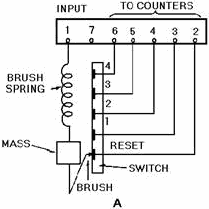
Figure 3-22A. - Pulse counting accelerometer.
3-22
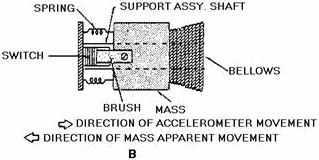
Figure 3-22B. - Pulse counting accelerometer.
When velocity remains constant, the brush spring holds the mass at null, and the brush rests on the reset
contact of the switch. As acceleration occurs, the tendency of the mass to remain at a constant velocity causes
the spring to compress. As the spring compresses, it allows the brush to move off the reset contact. If the
acceleration is great enough, the brush will pass over the switch contacts for acceleration levels 1, 2, 3, and 4.
These levels are determined by the stiffness of the spring.
As the brush passes over each contact (in a positive direction), an output pulse from each contact is coupled
to one of four counters. This advances the counter one-half count. The accelerometer is designed so that as
acceleration decreases, the mass tends to assume the new velocity. The counters will not advance the remaining
half count until the brush once again touches the reset contact. With this type of pulse output, it is possible to
record each time gravity forces have reached a predetermined level. Q-21. Operation of an accelerometer
is based on what physical property? Q-22. What type of systems primarily use accelerometers?
Q-23. What special requirement is the pulse counting accelerometer designed for?
Summary
In this chapter you were introduced to the subject of gyros. You studied the characteristics of gyros and
several applications of their use. You were also briefly introduced to the subject of accelerometers. The
following information provides a summary of the chapter. The term GYROSCOPE (or GYRO) may
be applied to any rapidly spinning object; however, a functional gyroscope is constructed and mounted to take
advantage of certain characteristics.
3-23

RIGIDITY in a gyro is the tendency of a spinning wheel (rotor) to remain in a fixed position
in space. PRECESSION is the property of a gyro that causes it to tilt in a direction
perpendicular to the direction of any outside force. The COMPONENTS of a UNIVERSALLY MOUNTED GYRO
are: the Rotor, the Inner Gimbal, the Outer Gimbal, and the Base.
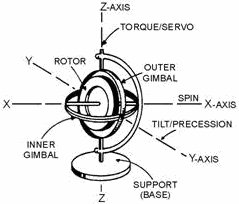
The Factors THAT EFFECT RIGIDITY are the weight, shape, and speed of rotation of the rotor.
3-24
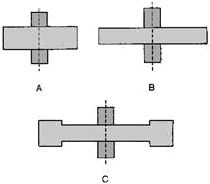
The DirectION of PRECESSION in a gyro is always 90º from the direction of the applied force.
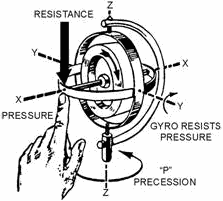
A GYRO ERECTION System must be capable of sensing the difference between the present rotor
position and the desired rotor position, and must apply forces that will cause the gyro to precess toward the
desired position. The mercury erection system discussed in this chapter is only one of several possible types of
gyro erection systems.
3-25
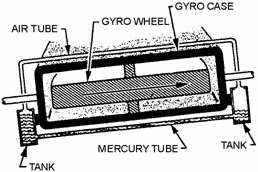
RATE GYROS are specially mounted so they are free to precess in only one direction; they are used to measure angular rates.
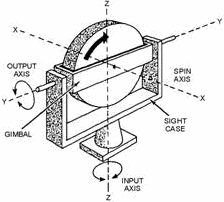
An ACCELEROMETER is a device used to detect and measure any acceleration along a particular
axis.

3-26
Answers to Questions Q1. Through Q23.
A-1. Yes. A-2. X-axis. A-3. Rigidity.
A-4. Any force that attempts to tilt the spin axis. A-5. Perpendicular (90º) to
the force. A-6. Two. A-7. Rotor speed, weight, shape.
A-8. C. A-9. Force of translation. A-10. Rigidity.
A-11. Direction of spin. A-12. Middle finger. A-13. Two.
A-14. Horizontal. A-15. Unbalanced gyro, inertia of gimbals, bearing friction.
A-16. To achieve and maintain the proper operating position for the gyro (usually vertical or
horizontal). A-17. Applies torque at the proper point for correct precession.
A-18. Measuring angular rates. A-19. One. A-20. Precession.
A-21. Inertia. A-22. Navigation systems. A-23. When digital
data is required from an accelerometer.
3-27
| - |
Matter, Energy,
and Direct Current |
| - |
Alternating Current and Transformers |
| - |
Circuit Protection, Control, and Measurement |
| - |
Electrical Conductors, Wiring Techniques,
and Schematic Reading |
| - |
Generators and Motors |
| - |
Electronic Emission, Tubes, and Power Supplies |
| - |
Solid-State Devices and Power Supplies |
| - |
Amplifiers |
| - |
Wave-Generation and Wave-Shaping Circuits |
| - |
Wave Propagation, Transmission Lines, and
Antennas |
| - |
Microwave Principles |
| - |
Modulation Principles |
| - |
Introduction to Number Systems and Logic Circuits |
| - |
- Introduction to Microelectronics |
| - |
Principles of Synchros, Servos, and Gyros |
| - |
Introduction to Test Equipment |
| - |
Radio-Frequency Communications Principles |
| - |
Radar Principles |
| - |
The Technician's Handbook, Master Glossary |
| - |
Test Methods and Practices |
| - |
Introduction to Digital Computers |
| - |
Magnetic Recording |
| - |
Introduction to Fiber Optics |
| Note: Navy Electricity and Electronics Training
Series (NEETS) content is U.S. Navy property in the public domain. |
|



















